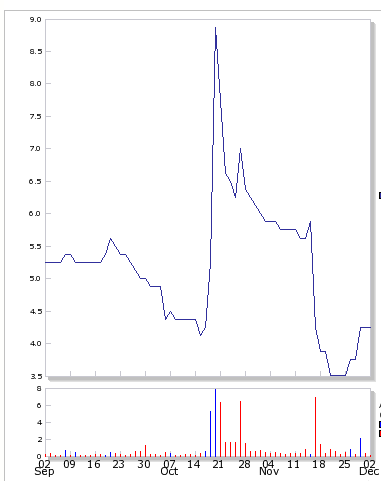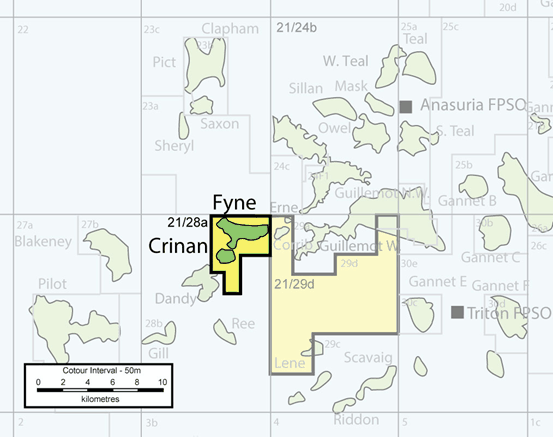Is Antrim Energy worth a punt?
Dec 2, 2013 at 5:57 pm in AIM by contrarianuk
The Irish focused oil and gas explorer caught my attention in the last few weeks after a serious plunge in its share price. According to the company web site, ‘Antrim’s overall objective is to create significant wealth for its investors through the discovery, production and sale of oil and gas. Strong revenue generation coupled with strategic partnerships ensure that the Company maintains financial and operational growth.’
On the point about significant wealth for its shareholders, it has failed abysmally. The shares are now at 4p, down 90% in the last year after a series of operational problems and funding crises.
The company was founded in 1999, and is listed on the Toronto Stock Exchange in 2001 and AIM (ticker AEY) on 2003 with its primary assets now in Irish waters.
Main assets
Causeway
Causeway production commenced in early November, 2012, with gross production rates of approximately 4,500 bopd (net 1,600 bopd to Antrim) Production has since declined to approximately 3,000 bopd.
Fionn
Projected costs associated with the development of the Fionn Field increased to the extent that the project no longer met Antrim’s economic criteria. In Q1 2013, Antrim therefore elected to opt out of the Fionn Field development. Subject to all necessary approvals from DECC, Antrim will withdraw from the Fionn Field subarea.
Cormorant
Cormorant East commenced production in January 2013 at an initial production rate of approximately 5,500 bopd (net Antrim approximately 460 bopd), with no water. Production has since declined to approximately 500 bopd. TAQA has plans recomplete the production well to improve production rates, and has proposed additional drilling for late 2013.
Fyne
In Q2 2013, DECC agreed to amend the terms of the licence to allow for a revised Field Development Plan (“FDP”) for the Fyne Field to be submitted no later than 31 January 2014. In addition to Antrim relinquishing the Dandy and the Crinan prospective areas, DECC’s consent included the condition that the Fyne Field FDP submission is in its final form, the Environmental Statement is cleared, Antrim is approved as a Production Operator, there is satisfactory evidence of project financing, and first production is achieved prior to 25th November 2016. Subsequently, Antrim signed an agreement with Enegi Oil.
Trouble in store
The following article appeared in today’s Irish Examiner (http://www.irishexaminer.com/business/antrim-energys-survival-in-doubt-251360.html) .
“The Toronto-headquartered firm — which has interests in the North Sea, the Porcupine Basin off the west coast of Ireland, and Africa — is in discussions with lenders to “relax certain requirements” relating to its ability to access restricted funds, to quantify any additional funding requirements and to reassess terms based on the original production profile.
At the start of this year, Antrim entered into a $30m (€22m) payment swap transaction — subject to a number of financial and operating covenants and restrictions on various cash balances.
In a statement, Antrim’s management admitted that it expects to be in breach of certain covenants and had “insufficient cumulative production to remove restrictions related to the use of proceeds from oil sales”.
Antrim is also braced for higher-than-expected capital costs relating to the completion of its chief North Sea project, the Causeway oil field, regarding which it is required to pump extra funds into a reserve account with its lender.
Failure to fund capital costs could result in the loss of the asset. Antrim’s options include the sale of assets and it is taking advice on that.
“There are a number of material uncertainties that raise significant doubts as to the company’s ability to continue as a going concern, including compliance with debt covenants; the performance of producing wells and related infrastructure; oil prices; ability to finish the planned development programme for Causeway within budget; ability to secure additional financing; relinquishment of commitments on certain licences and settlement of contingencies.”
The last financial statement issued on 15th November 2013 gave an indication of the extent of the company’s problems. Insufficient cash flow to cover its commitments to develop its fields.
In the nine month period ended September 30, 2013, Antrim generated cash flow from operations of $9.1 million ($0.05 per share) compared to a cash deficiency from operations of $5.3 million ($0.03 per share) in the same period in 2012. Cash flow from operations increased due to the recognition of revenue from Causeway production.
The company had a net loss from continuing operations of $18.0 million compared to a net loss from continuing operations of $67.7 million in the same period in 2012. The net loss decreased primarily due to the recognition of revenue from Causeway production and a gain of $7.5 million on the disposal of the Tanzania option, higher impairment costs recorded in 2012 and a reduction in 2012 in the fair value of financial assets partially offset by a gain on disposal of the Company’s Argentina operations.
In the third quarter of 2013, Antrim had a net loss from continuing operations of $16.1 million compared to a net loss from continuing operations of $5.2 million in 2012.
The accounts said “There are a number of material uncertainties that raise significant doubts as to the Company’s ability to continue as a going concern, including compliance with debt covenants, the performance of producing wells and related infrastructure, oil prices, ability to finish the planned development program for Causeway within budget, ability to secure additional financing, relinquishment of commitments on certain licences and settlement of contingencies. See Going Concern on page 1 of the Company’s Management’s Discussion and Analysis for additional information.
As at September 30, 2013, Antrim had a working capital deficiency including debt of $14.4 million compared to a working capital deficiency of $10.7 million as at December 31, 2012. Accounts payable and accrued liabilities were $6.1 million at September 30, 2013 primarily related to costs for the development of the Causeway Field, compared to $18.2 million as at December 31, 2012.
Thoughts
Another day…another disaster for private investors. The big question is – is this the ultimate bottom fishing exercise and should I add to my speculative oil and gas portfolio? At 4p, this could be the opportunity for quick gains or perhaps this could drop to zero if a financial deal with its lenders doesn’t materialise.
 Interesting that Chairman of Antrim, Jerry Orbell was Chairman and Chief Executive of Sound Oil and he left in October 2012. Another AIM disaster, these things have a habit of repeating themselves.
Interesting that Chairman of Antrim, Jerry Orbell was Chairman and Chief Executive of Sound Oil and he left in October 2012. Another AIM disaster, these things have a habit of repeating themselves.
A 4p, the company is valued at £7.62 million, but decommissioning costs of Fionn as well as some invoicing issues mean that the company is potentially looking at a liability of $30-40 million including the $30 million payment swap transaction. The key is asset disposals and approval of the Fynn development. So the problem is too much costs to pay for on their fields and not enough revenue particularly with all the field down time they have experienced this year because of maintenance and other issues.
Potentially an opportunity to make 200-300% on a takeover, but a bit spicy for me! Another interesting case study in ‘buyer beware’ on AIM!
by the Contrarian Investor
IMPORTANT
The posts I make are in no way meant as investment suggestions or recommendations to any visitors to the site. They are simply my views on the markets and what trades I am placing myself. Anyone who wishes to spread bet or buy stocks should rely on their own due diligence and common sense before placing any spread trade.



